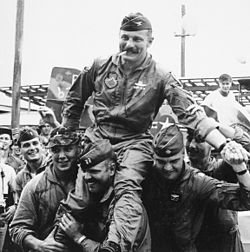
The F-4C arrived at an operational base for the first time 54 years ago today. It is my second favorite airplane of all time. What was so special about this fighter?
My love affair with the F-4 was first kindled on a later sunny summer afternoon in Anchorage Alaska. My Dad and I were driving by the flight line at Elmendorf AFB. Several F-4s sat line up near the runway, canopies open, and the glass glistening in the sun rays. I suspect they were lined up in scramble mode, ready for their pilot to ride them into the wild blue yonder to meet a short notice Red threat. In other words, the USSR was not far away and the F-4s could be called upon to meet any air threat from the Russian Bear.

The F-4 interest spark burst into flames when I was a cadet at the Air Force Academy. Many of my Academy instructors had flown them in Vietnam ten years prior. The names: Robin Olds, Chappie James, Steve Ritchie, Chuck DeBellevue, and Lance Sijan were known to all cadets, and they had all flown the F-4 Phantom. Lesser known individuals like Dan Autrey had also flown the Phantom. As I read the exploits of the aircraft, I dreamed of perhaps flying one someday, before transitioning to the F-15 or F-16.
I almost got my wish. At pilot training we learned that one or maybe two F-4s were being “dropped” (aka assigned) at assignment night. I considered maneuvering around in order to be in position to request one as my first choice. In the end I opted for the C-141 (I wanted to see the world and then go to the airlines). “Tates” got the F-4 Project Season to the Mississippi Air National Guard.
All this flooded back to my mind as I read that on November 20, 1963 the first operational F-4C Phantom arrived at MacDill AFB near Tampa Florida. McDill is known these days as the headquarters of Central Command. The Command from which Norman Schwarzkopf led the brilliant victory in the First Gulf War.

The Air Force hates to admit that they would get anything from the US Navy, especially an airplane. However, that is exactly what happened with the F-4. The Navy had been flying B models. The Air Force tested them against their current air to air interceptor, the F-106 Delta Dart (see photo at right), and found the F-4 to be superior. They put in an order from McDonnell Douglas, the Phantom manufacturer. Several modifications were made, chief among them there was no need for a catapult system from which to take off from an aircraft carrier.
Originally, the C model was equipped with only missiles. It was the first fighter not to be armed with a gun. “Experts’ felt that the missile had made gun or cannon fire obsolete. The F-4 was armed with sidewinder and sparrow missiles. Soon, combat in Vietnam against enemy MIGs proved the “experts” wrong. A later rendition, the F-4E, incorporated a gun sight and internal guns in addition to the missiles.


The McDonnell Douglas plant in St. Louis turned out the F-4 by the thousands – at roughly one million dollars apiece. The F-4 had become the jet fighter of choice in Vietnam and that war was heating up. Robin Olds, a World War II ace, and flying legend recorded four kills with the F-4C in combat – two kills occurred on the same mission. Olds’ aircraft is on display at the Air Force Museum (with the FG tail number). see: http://www.nationalmuseum.af.mil/Visit/Museum-Exhibits/Fact-Sheets/Display/Article/196051/mcdonnell-douglas-f-4c-phantom-ii/

The F-4 had a long and storied career. The last one rolled off the assembly line in 1979. For a short time (’69 – ’73) it served as the Thunderbirds’ aircraft. However, its flying characteristics were much more suited to combat than aerial demonstration. It was known as “the brick that could fly”. By the time I came along to the operational Air Force, the joke was that the F-4 pilot should go ahead and declare an emergency before takeoff, that way everyone could be ready earlier for the inevitable emergency to occur each flight. Despite the flaws, the F-4 proved to be a steady workhorse. You can see a video of its last flight at: https://www.youtube.com/watch?v=rT_gLtwAjBs
That distinguished career started 54 years ago today. For more information on that first operational F-4 see the following website: https://www.thisdayinaviation.com/

send issues of AOA and Interceptor magazines please. Thank you
Jay, is this meant for the F-4 community?